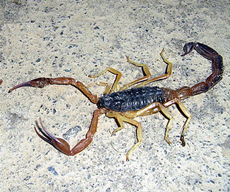Bites and Stings Poisoning
 |
| Bites and Stings Poisoning |
Bites and stings poisoning or hypersensitivity response (allergic reaction) to insect and reptile venoms.
Though numerous insects sting and spiders and snakes bite, most are not poisonous (harmful beyond local discomfort at the site of the sting or bite). Rapid first resonse efforts can often reduce the severity of the resulting injury from poisonous stings and bites.
Hymenoptera stings
The most common stings come from wasps, hornets, yellow jackets, honey bees, and fire ants, collectively known as the Hymenoptera order.
  |
For the two million Americans who are allergic to the venom of these insects, the sting is far more significant than irritation or discomfort. Severe hypersensitivity response can cause swelling of the throat that blocks the airway; anaphylactic shock is a life-threatening circumstance.
First response for Hymenoptera stings:
- Gently scrape the stinger out of the wound with the edge of an object such as a credit card. Do not grasp the stinger with tweezers or fingernails as this squeezes the venom sack and forces more venom into the wound.
- Apply ice until the area is numb.
- Make a paste of baking soda and water and liberally spread it over the area of the sting (Alternately, apply a small amount of hydrocortisone cream or diphenhydramine cream.)
- Seek further evaluation and treatment from a health-care provider when pain persists or worsens, or when the person stung has a hypersensitivity response (allergic reaction).
Poisonous spider bites and scorpion stings
There are only two types of poisonous spiders in North America, the widows (of which the black widow is the most notorious species) and the brown recluse. There is one species of poisonous scorpion, Centruroides sculpturatus, found in the
southwestern United States (particularly Arizona) and northern Mexico.
The venom of a widow spider is a neurotoxin that produces pain and swelling at the site of the bite and systemic effects that may include generalized discomfort or pain, muscle cramp, and muscle spasm. It may also elevate blood Pressure (hypertension).
 |
| scorpion |
First response for poisonous scorpion stings and spider bites:
- Apply ice to the bite.
- Minimize movement of the bitten area; splint if possible.
- Seek immediate medical care at a hospital emergency department. Antivenin is available for widow spider and C. sculpturatus scorpion bites.
Poisonous snake bites
There are four types of poisonous snakes in North America, the bites of which are all capable of causing death. Antivenin is available for each type. Bites from poisonous snakes require urgent medical treatment at a hospital emergency department.
First response for snake bite:
- Loosely splint or otherwise immobilize the area of the bite, and keep it lower than the heart.
- Keep the bitten person calm and still.
- If it will be longer than 30 minutes before the bitten person can get to a hospital, wrap a bandage (or improvise with a scarf or other item of clothing) firmly but not tightly three to four inches above the bite, between the bite and the heart.
The tightness of the wrap should be such that the responder’s finger can fit under it. After placing such a bandage, do not remove it for any reason. Doing so will release a surge of venom into the person’s blood circulation.
Stings from stingrays, jellyfish, and sea urchins
 |
| jellyfish |
Numerous species common in the oceans in the coastal United States can deliver a significant sting. Stingrays and sea urchins sting with spines coated in venom.
The spines may break off under the skin, continuing to release venom. They also present very high risk for bacterial infection. Heat inactivates the venom and vinegar dissolves the spines.
First response for stingray and sea urchin stings:
- Soak the area of the sting in water as hot as the person stung can tolerate for at least 30 minutes.
- After the hot water soak, place gauze pads soaked in vinegar over the sting area.
- Repeat these measures until symptoms improve or the stung person reaches a hospital for further treatment.
Jellyfish and related creatures such as sea anemones and Portuguese man-o-war have clusters of long tentacles covered with stinging cells.
First response for these stings:
- Flush the area of the sting with seawater.
- Place gauze pads soaked in vinegar over the sting area for at least 30 minutes.
- Use gloved hands or tweezers to remove tentacles.
- Repeat steps 2 and 3 until all tentacles are gone and pain subsides.
- Seek treatment at a hospital emergency department.


